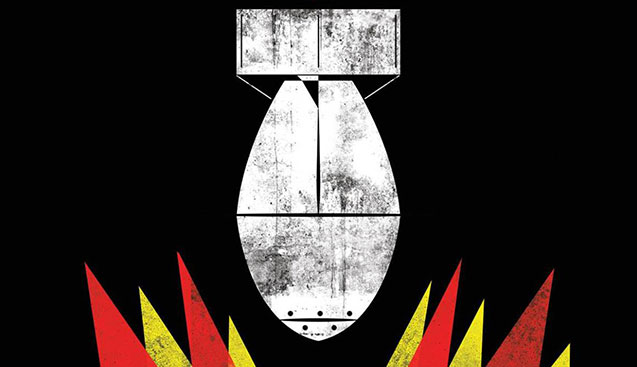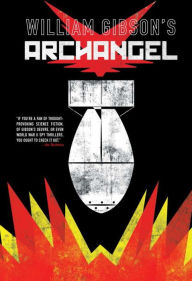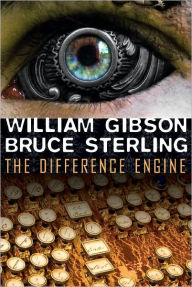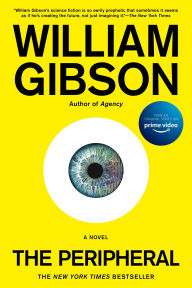William Gibson’s Archangel Is a Story That Demanded to Be a Comic
 William Gibson is a living legend of science fiction, credited with coining the phrase “cyberspace,” bringing cyberpunk into the mainstream, and codifying elements of early internet culture that went on to become mainstream (well, not so much the cyborg dolphins…). It’s thus no surprise that every new book from Gibson feels like an event—none more so than his latest work, Archangel, his first ever comic book, which will be released in a complete hardcover edition next month.
William Gibson is a living legend of science fiction, credited with coining the phrase “cyberspace,” bringing cyberpunk into the mainstream, and codifying elements of early internet culture that went on to become mainstream (well, not so much the cyborg dolphins…). It’s thus no surprise that every new book from Gibson feels like an event—none more so than his latest work, Archangel, his first ever comic book, which will be released in a complete hardcover edition next month.
William Gibson's Archangel Graphic Novel
William Gibson's Archangel Graphic Novel
By
William Gibson
,
Michael St. John Smith
Illustrator
Butch Guice
,
Alejandro Barrionuevo
,
Wagner Reis
Hardcover $24.99
The book is set in an alternate 2016. Then-Vice President Junior Henderson undergoes a facelift in order to look like his grandfather, then uses experimental technology called the Splitter to travel back to 1945, kill his own grandfather, and take power (if you’re getting ready to cry “Paradox!” well, you’ll just have to read the book). In the future, a faction opposed to Henderson, led by a soldier named Torres, tries to take control of the device to set things right, while in the past, an RAF officer named Naomi Givens investigates a strange plane crash in Berlin. A conspiracy unwinds across two timelines as Naomi and her ex-boyfriend, U.S. Intelligence agent Vince Mathews, begin to suspect Henderson is, impossibly, not the man he seems to be.
It’s a typically twisting, complex narrative befitting Gibson’s reputation as a master of complex, layered storytelling, and yet it also feels perfectly suited to the medium. Some time back—in fact, it was during San Diego Comic-Con 2016, which just goes to show you that timelines in publishing, like timelines in a William Gibson novel, are rarely predictable—we talked with Gibson about how Archangel came to be, why it the story had to be told as a comic, and whether or not it ties into any of his novels.
[caption id="attachment_20713" align="alignright" width="200"] William Gibson[/caption]
What made you want to do a comic?
We weren’t thinking initially in terms of a comic. Initially we thought we were writing a feature screenplay. At one point we were thinking about a computer game. We’d come up with a world and characters and we didn’t know where to go with it. Then IDW approached me about doing a comic.
Independently of anything?
Yes, independently of anything else. And we said, “Well, look at this.” And they were so much more enthusiastic about it as a comic than anyone else had been about it as anything else, that it seemed to be the thing to do.
Is there something in particular about Archangel that you think is more suited to comics over another visual medium or even a novel?
That puzzles me, because I think what we came up with works better as a limited comic than it would have as anything else. I didn’t ever think it was really quite right for a feature film. I wouldn’t have wanted to try to turn it into a novel. It now seems to me to fit the form. Though that’s very after the fact, of course.
Something in the birthing of it made it seem like that was what it should have been all along?
Yes—it became more itself as I worked on it with the people at IDW.
The book is set in an alternate 2016. Then-Vice President Junior Henderson undergoes a facelift in order to look like his grandfather, then uses experimental technology called the Splitter to travel back to 1945, kill his own grandfather, and take power (if you’re getting ready to cry “Paradox!” well, you’ll just have to read the book). In the future, a faction opposed to Henderson, led by a soldier named Torres, tries to take control of the device to set things right, while in the past, an RAF officer named Naomi Givens investigates a strange plane crash in Berlin. A conspiracy unwinds across two timelines as Naomi and her ex-boyfriend, U.S. Intelligence agent Vince Mathews, begin to suspect Henderson is, impossibly, not the man he seems to be.
It’s a typically twisting, complex narrative befitting Gibson’s reputation as a master of complex, layered storytelling, and yet it also feels perfectly suited to the medium. Some time back—in fact, it was during San Diego Comic-Con 2016, which just goes to show you that timelines in publishing, like timelines in a William Gibson novel, are rarely predictable—we talked with Gibson about how Archangel came to be, why it the story had to be told as a comic, and whether or not it ties into any of his novels.
[caption id="attachment_20713" align="alignright" width="200"] William Gibson[/caption]
What made you want to do a comic?
We weren’t thinking initially in terms of a comic. Initially we thought we were writing a feature screenplay. At one point we were thinking about a computer game. We’d come up with a world and characters and we didn’t know where to go with it. Then IDW approached me about doing a comic.
Independently of anything?
Yes, independently of anything else. And we said, “Well, look at this.” And they were so much more enthusiastic about it as a comic than anyone else had been about it as anything else, that it seemed to be the thing to do.
Is there something in particular about Archangel that you think is more suited to comics over another visual medium or even a novel?
That puzzles me, because I think what we came up with works better as a limited comic than it would have as anything else. I didn’t ever think it was really quite right for a feature film. I wouldn’t have wanted to try to turn it into a novel. It now seems to me to fit the form. Though that’s very after the fact, of course.
Something in the birthing of it made it seem like that was what it should have been all along?
Yes—it became more itself as I worked on it with the people at IDW.
The Difference Engine: A Novel
The Difference Engine: A Novel
By
William Gibson
Contribution by
Bruce Sterling
In Stock Online
Paperback $17.00
You’re known for being a novelist, and writing a solo novel is obviously a sort of solipsistic, personal journey you’re on. Is this the most you’ve collaborated on a project?
Not really—I wrote The Difference Engine with Bruce Sterling, which was a huge collaboration that took many years. And our friendship survived it! At one time novelists thought of collaboration as being not an impossible thing.
Especially in science fiction.
It’s fairly common in science fiction. That was one of the things that kept science fiction from being thought of as literature, because so often it was collaborative work. But Joseph Conrad for instance thought it was OK to do collaborative work. I was always torn between wanting to satisfy the auteur theory of literature and wanting to do this really genre thing of totally co-writing something. I would never set out to collaborate without having something to do. Every thing I’ve collaborated on, the circumstances and development of the idea have forced the collaboration.
What was your collaborative process like on this project, working with artists (art by Butch Guice and Tom Palmer, colors by Diego Rodriguez, and lettering by Shawn Lee) used to expressing themselves visually as opposed to through prose like you are?
It’s two different kinds of collaboration. What [co-writer Michael St. John Smith] and I were originally doing was passing this narrative back and forth, overwriting one another. When it got to IDW, people became involved who were very professionally skilled in the visual presentation of narrative in ways that we weren’t at all. So it’s a slightly different kind of back and forth.
Did that change the shape of the story, once you were squeezing it into this new shape?
It made it to my amazement, it made it more itself. It lost some things that I think had been an attempt to seem like a screenplay for a future film, which I think had made it swollen in places. It became leaner, more truly linear as a script for a comic.
Do you think having done this, that you would do another comic?
I enjoyed the process hugely, but I’d have to have something that I really needed to do.
Especially because this one didn’t start out as a comic, it just happened to go that way. Do you think this is the end of this story, after these 5 issues? Could you stay around in this universe and play a little more?
That’s always up in the air to some extent with any of my narratives.
You do love your trilogies…
Yes, but I’m also somewhat famous in my own house for swearing that the first one is a one-off…
You’re known for being a novelist, and writing a solo novel is obviously a sort of solipsistic, personal journey you’re on. Is this the most you’ve collaborated on a project?
Not really—I wrote The Difference Engine with Bruce Sterling, which was a huge collaboration that took many years. And our friendship survived it! At one time novelists thought of collaboration as being not an impossible thing.
Especially in science fiction.
It’s fairly common in science fiction. That was one of the things that kept science fiction from being thought of as literature, because so often it was collaborative work. But Joseph Conrad for instance thought it was OK to do collaborative work. I was always torn between wanting to satisfy the auteur theory of literature and wanting to do this really genre thing of totally co-writing something. I would never set out to collaborate without having something to do. Every thing I’ve collaborated on, the circumstances and development of the idea have forced the collaboration.
What was your collaborative process like on this project, working with artists (art by Butch Guice and Tom Palmer, colors by Diego Rodriguez, and lettering by Shawn Lee) used to expressing themselves visually as opposed to through prose like you are?
It’s two different kinds of collaboration. What [co-writer Michael St. John Smith] and I were originally doing was passing this narrative back and forth, overwriting one another. When it got to IDW, people became involved who were very professionally skilled in the visual presentation of narrative in ways that we weren’t at all. So it’s a slightly different kind of back and forth.
Did that change the shape of the story, once you were squeezing it into this new shape?
It made it to my amazement, it made it more itself. It lost some things that I think had been an attempt to seem like a screenplay for a future film, which I think had made it swollen in places. It became leaner, more truly linear as a script for a comic.
Do you think having done this, that you would do another comic?
I enjoyed the process hugely, but I’d have to have something that I really needed to do.
Especially because this one didn’t start out as a comic, it just happened to go that way. Do you think this is the end of this story, after these 5 issues? Could you stay around in this universe and play a little more?
That’s always up in the air to some extent with any of my narratives.
You do love your trilogies…
Yes, but I’m also somewhat famous in my own house for swearing that the first one is a one-off…
The Peripheral (The Jackpot Trilogy #1)
The Peripheral (The Jackpot Trilogy #1)
In Stock Online
Paperback $19.00
I’m waiting for my sequel to The Peripheral.
I currently can’t tell if I’m writing that or not! That’s owing to the structure of that novel [editor’s note: the plot device at the center of the novel allows for communication between countless alternate timelines, set in our future but in the “past” of the book’s “present,” and if you’re confused yet, well, it’s William Gibson]. I started writing something set next year in San Francisco thinking it wasn’t going to be connected at all, and I’ve come to suspect the hand of [The Peripheral] in there. It may wind up not as a sequel but what the Victorians call and “appendant.” [Editor’s note: since this interview took place, Gibson announced more about his next book, Agency, and confirmed it is indeed a sort of companion to The Peripheral.]
How do you think Archangel fits into your body of work? Do you think it’s of a piece, or does it sit somewhere outside?
It feels to me very much in keeping, or at least as much in keeping with everything else I’ve done as The Difference Engine. Which is very different from everything else I’ve done but it addresses the same kinds of things. We began working on early versions of this just before I started writing The Peripheral. I began [that book] without knowing that it had that far-future element. It was all set in the trailer park world of the near future. It was the version of time travel we created in Archangel that I applied to the trailer park world that actually produced the future timeline in The Peripheral.
So is it possible Archangel is set in the world of The Peripheral?
Not according to the canonical rules of The Peripheral, because there’s a specific year given at which point the future can’t communicate with the past. I think somebody suggested it might be because the internet isn’t sophisticated enough prior to that point. So for them to be able to reach back to 1945, I don’t think that would work.
Archangel is available in hardcover October 3.
I’m waiting for my sequel to The Peripheral.
I currently can’t tell if I’m writing that or not! That’s owing to the structure of that novel [editor’s note: the plot device at the center of the novel allows for communication between countless alternate timelines, set in our future but in the “past” of the book’s “present,” and if you’re confused yet, well, it’s William Gibson]. I started writing something set next year in San Francisco thinking it wasn’t going to be connected at all, and I’ve come to suspect the hand of [The Peripheral] in there. It may wind up not as a sequel but what the Victorians call and “appendant.” [Editor’s note: since this interview took place, Gibson announced more about his next book, Agency, and confirmed it is indeed a sort of companion to The Peripheral.]
How do you think Archangel fits into your body of work? Do you think it’s of a piece, or does it sit somewhere outside?
It feels to me very much in keeping, or at least as much in keeping with everything else I’ve done as The Difference Engine. Which is very different from everything else I’ve done but it addresses the same kinds of things. We began working on early versions of this just before I started writing The Peripheral. I began [that book] without knowing that it had that far-future element. It was all set in the trailer park world of the near future. It was the version of time travel we created in Archangel that I applied to the trailer park world that actually produced the future timeline in The Peripheral.
So is it possible Archangel is set in the world of The Peripheral?
Not according to the canonical rules of The Peripheral, because there’s a specific year given at which point the future can’t communicate with the past. I think somebody suggested it might be because the internet isn’t sophisticated enough prior to that point. So for them to be able to reach back to 1945, I don’t think that would work.
Archangel is available in hardcover October 3.


